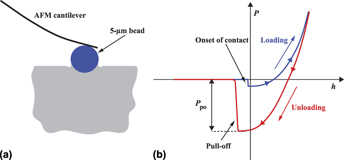Crossref Citations
This article has been cited by the following publications. This list is generated based on data provided by
Crossref.
Liu, Bernard Haochih
Li, Kun-Lin
Kang, Kai-Li
Huang, Wen-Ke
and
Liao, Jiunn-Der
2013.
In situbiosensing of the nanomechanical property and electrochemical spectroscopy ofStreptococcus mutans-containing biofilms.
Journal of Physics D: Applied Physics,
Vol. 46,
Issue. 27,
p.
275401.
Varughese, Sunil
Kiran, M. S. R. N.
Ramamurty, Upadrasta
and
Desiraju, Gautam R.
2013.
Nanoindentation im Kristall‐Engineering: Quantifizierung mechanischer Eigenschaften von Molekülkristallen.
Angewandte Chemie,
Vol. 125,
Issue. 10,
p.
2765.
Borodich, Feodor M.
Galanov, Boris A.
Gorb, Stanislav N.
Prostov, Mikhail Y.
Prostov, Yuriy I.
and
Suarez‐Alvarez, Maria M.
2013.
Evaluation of Adhesive and Elastic Properties of Polymers by the BG Method.
Macromolecular Reaction Engineering,
Vol. 7,
Issue. 10,
p.
555.
Cohen, Sidney R
and
Kalfon-Cohen, Estelle
2013.
Dynamic nanoindentation by instrumented nanoindentation and force microscopy: a comparative review.
Beilstein Journal of Nanotechnology,
Vol. 4,
Issue. ,
p.
815.
Wang, Haoran
Wang, Xinnan
Li, Tao
and
Lee, Byeongdu
2013.
Nanomechanical characterization of rod-like superlattice assembled from tobacco mosaic viruses.
Journal of Applied Physics,
Vol. 113,
Issue. 2,
Varughese, Sunil
Kiran, M. S. R. N.
Ramamurty, Upadrasta
and
Desiraju, Gautam R.
2013.
Nanoindentation in Crystal Engineering: Quantifying Mechanical Properties of Molecular Crystals.
Angewandte Chemie International Edition,
Vol. 52,
Issue. 10,
p.
2701.
Moshtagh, P.R.
Rauker, J.
Sandker, M.J.
Zuiddam, M.R.
Dirne, F.W.A.
Klijnstra, E.
Duque, L.
Steendam, R.
Weinans, H.
and
Zadpoor, A.A.
2014.
Nanomechanical properties of multi-block copolymer microspheres for drug delivery applications.
Journal of the Mechanical Behavior of Biomedical Materials,
Vol. 34,
Issue. ,
p.
313.
Borodich, Feodor M.
2014.
Vol. 47,
Issue. ,
p.
225.
Samuel, R
Thacker, C M
Maricq, A V
and
Gale, B K
2014.
Simple and cost-effective fabrication of microvalve arrays in PDMS using laser cut molds with application toC. elegansmanipulation in microfluidics.
Journal of Micromechanics and Microengineering,
Vol. 24,
Issue. 10,
p.
105007.
Lu, Pin
2015.
A Study of Particles Adhesion to Compliant Substrates with a Modified Sphere Contact Model.
Tribology Letters,
Vol. 58,
Issue. 1,
Yu, Yalin
Sanchez, Daniel
and
Lu, Nanshu
2015.
Work of adhesion/separation between soft elastomers of different mixing ratios.
Journal of Materials Research,
Vol. 30,
Issue. 18,
p.
2702.
Díez-Pascual, Ana M.
Gómez-Fatou, Marián A.
Ania, Fernando
and
Flores, Araceli
2015.
Nanoindentation in polymer nanocomposites.
Progress in Materials Science,
Vol. 67,
Issue. ,
p.
1.
Zamil, M. Shafayet
Yi, Hojae
and
Puri, Virendra M.
2015.
The mechanical properties of plant cell walls soft material at the subcellular scale: the implications of water and of the intercellular boundaries.
Journal of Materials Science,
Vol. 50,
Issue. 20,
p.
6608.
Cheng, M H
Flores De Jesus, K
Cronin, S D
Sierros, K A
and
Bakhoum, E
2015.
A versatile spatial resolution enhancement method for data acquisition.
Measurement Science and Technology,
Vol. 26,
Issue. 4,
p.
045901.
Tsaira, Aikaterini
Karagiannidis, Panagiotis
Sidira, Margarita
Kassavetis, Spyros
Kugiumtzis, Dimitris
Logothetidis, Stergios
Naka, Olga
Pissiotis, Argirios
and
Michalakis, Konstantinos
2016.
Theoretical Considerations and a Mathematical Model for the Analysis of the Biomechanical Response of Human Keratinized Oral Mucosa.
Frontiers in Physiology,
Vol. 7,
Issue. ,
Enrique-Jimenez, P.
Quiles-Díaz, S.
Salavagione, H.J.
Wesner, D.
Schönherr, H.
González-Casablanca, J.
García-Quismondo, R.
Martínez, G.
Gómez-Fatou, M.A.
Ania, F.
and
Flores, A.
2017.
Control of the structure and properties of SEBS nanocomposites via chemical modification of graphene with polymer brushes.
European Polymer Journal,
Vol. 97,
Issue. ,
p.
1.
Liu, Yu
Bao, Chao
Nie, Heng-yong
Hui, David
Mei, Jun
and
Lau, Woon-ming
2017.
Carbon-related Materials in Recognition of Nobel Lectures by Prof. Akira Suzuki in ICCE.
p.
421.
Yoshie, Haruka
Koushki, Newsha
Kaviani, Rosa
Tabatabaei, Mohammad
Rajendran, Kavitha
Dang, Quynh
Husain, Amjad
Yao, Sean
Li, Chuck
Sullivan, John K.
Saint-Geniez, Magali
Krishnan, Ramaswamy
and
Ehrlicher, Allen J.
2018.
Traction Force Screening Enabled by Compliant PDMS Elastomers.
Biophysical Journal,
Vol. 114,
Issue. 9,
p.
2194.
Moshtagh, Parisa R.
Korthagen, Nicoline M.
van Rijen, Mattie H.P.
Castelein, Rene M.
Zadpoor, Amir A.
and
Weinans, Harrie
2018.
Effects of non-enzymatic glycation on the micro- and nano-mechanics of articular cartilage.
Journal of the Mechanical Behavior of Biomedical Materials,
Vol. 77,
Issue. ,
p.
551.
Lu, Shih-Chuan
Du, Wun-Ruei
Huang, Yi-Chen
Tsai, Chun-Pu
and
Li, Wei-Chang
2018.
MEMS Surface Coating Condition Monitoring via Nonlinear Tapping of Resoswitches.
p.
1.
